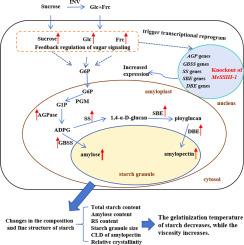Editing of the soluble starch synthase gene MeSSIII-1 enhanced the amylose and resistant starch contents in cassava
IF 10.7
1区 化学
Q1 CHEMISTRY, APPLIED
引用次数: 0
Abstract
Foods with high amylose and resistant starch (RS) contents have great potential to enhance human health. In this study, cassava soluble starch synthase MeSSIII-1 gene mutants were generated using CRISPR/Cas9 system. The results showed that the storage roots of messiii-1 mutants had higher contents of amylose, RS, and total starch than those in CK. The rates of small and large-sized starch granules were increased. Additionally, amylopectin starch in messiii-1 mutants had a higher proportion of medium- and long- chains, and a lower proportion of short-chains than those in CK. The onset, peak, and conclusion temperatures of starch gelatinization in messiii-1 mutants were significantly lower than those in CK, and the peak viscosity, trough viscosity and final viscosity all increased. MeSSIII-1 mutation could increase the contents of sucrose, glucose, and fructose in cassava storage roots. We hypothesize that these soluble sugars serve a dual role: they provide the necessary carbon source for starch synthesis and act as sugar signals to trigger the transcriptional reprogramming of genes involved in starch biosynthesis. This process results in a collective enhancement of amylose, RS, and total starch contents, accompanied by changes in starch granule morphology, fine structure, and physicochemical properties.

编辑可溶性淀粉合成酶基因 MeSSIII-1 可提高木薯中直链淀粉和抗性淀粉的含量
直链淀粉和抗性淀粉(RS)含量高的食品在增进人类健康方面具有巨大潜力。本研究利用 CRISPR/Cas9 系统生成了木薯可溶性淀粉合成酶 MeSSIII-1 基因突变株。结果表明,messiii-1 突变体的贮藏根中直链淀粉、RS 和总淀粉含量均高于 CK。小尺寸和大尺寸淀粉颗粒的比率都有所增加。此外,与 CK 相比,messiii-1 突变体中直链淀粉的中、长链比例更高,短链比例更低。messiii-1突变体中淀粉糊化的起始温度、峰值温度和结束温度都明显低于CK,峰值粘度、谷值粘度和最终粘度都有所增加。MeSSIII-1 突变可增加木薯贮藏根中蔗糖、葡萄糖和果糖的含量。我们推测这些可溶性糖具有双重作用:它们为淀粉合成提供必要的碳源,并作为糖信号触发参与淀粉生物合成的基因的转录重编程。这一过程导致直链淀粉、RS 和总淀粉含量的共同提高,并伴随着淀粉颗粒形态、精细结构和理化性质的变化。
本文章由计算机程序翻译,如有差异,请以英文原文为准。
求助全文
约1分钟内获得全文
求助全文
来源期刊

Carbohydrate Polymers
化学-高分子科学
CiteScore
22.40
自引率
8.00%
发文量
1286
审稿时长
47 days
期刊介绍:
Carbohydrate Polymers stands as a prominent journal in the glycoscience field, dedicated to exploring and harnessing the potential of polysaccharides with applications spanning bioenergy, bioplastics, biomaterials, biorefining, chemistry, drug delivery, food, health, nanotechnology, packaging, paper, pharmaceuticals, medicine, oil recovery, textiles, tissue engineering, wood, and various aspects of glycoscience.
The journal emphasizes the central role of well-characterized carbohydrate polymers, highlighting their significance as the primary focus rather than a peripheral topic. Each paper must prominently feature at least one named carbohydrate polymer, evident in both citation and title, with a commitment to innovative research that advances scientific knowledge.
 求助内容:
求助内容: 应助结果提醒方式:
应助结果提醒方式:


